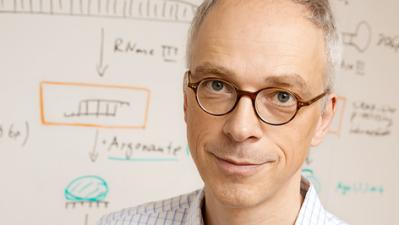Philippe Cinquin, Serge Cosnier, Chantal Gondran, Fabien Giroud
Implantable biofuel cell that runs on glucose
Finalists for the European Inventor Award 2014
The invention by Philippe Cinquin, Serge Cosnier and their team at Joseph Fourier University in France is effectively a "living battery" - a fuel cell and conductive wires modified with reactive enzymes that have the power to tap into the body's endless supply of glucose and convert the simple sugar, which constitutes the energy source of living cells, into electricity.
Visions of implantable biofuel cells that use the body's natural energy sources to power pacemakers or artificial hearts have been around since the 1960s, but it is the French team's innovations that represents the closest anyone has ever come to harnessing the energy. In the process, they managed to merge their findings in completely different fields to develop their highly promising invention.
Societal benefit
Philippe Cinquin and Serge Cosnier's biofuel cell promises relief for millions of people who rely on implanted medical devices, such as pacemakers, for their health and wellbeing. Pacemakers do save lives, but their shelf life is limited because their batteries are exhausted after eight years. Invasive surgery is then required, which can be both risky and costly. The French scientists' fuel cell would offer an inexhaustible source of energy and revolutionise the power supply to medical devices in the human body.
Economic benefit
While no biofuel cell technology has been introduced to the market yet, the inventors' research offers lucrative prospects for a number of fields, particularly in the medical industry. In 2010, the global market for microelectronic medical implants, accessories and supplies was worth an estimated US $11.1 billion and is expected to grow to $17.9 billion in 2016, with an 8.9% compound annual growth rate over the forecast period.
The fastest-growing segments of this market are ear implants, neurostimulators and implantable drug pumps. Powering such implants is a major issue, particularly for devices that have a stimulative function or devices that perform a continuous sensing function. Technologies that aim to harvest energy produced by the body are considered the future for powering electronic implants; Philippe Cinquin and Serge Cosnier's biofuel cell is among these technologies.
How it works
Biofuel cells that harvest energy from glucose in the body function much like every-day batteries that conduct electricity through positive and negative terminals called anodes and cathodes and a medium conducive to electric charge known as the electrolyte. Electricity is produced via a series of electrochemical reactions between these three components. These reactions are catalysed using enzymes that react with glucose stored in the blood.
Bodily fluids, which contain glucose and oxygen, serve as the electrolyte. To create an anode, two enzymes are used. The first enzyme breaks down the sugar glucose, which is produced every time the animal or person consumes food. The second enzyme oxidises the simpler sugars to release electrons. A current then flows as the electrons are drawn to the cathode. A capacitor that is hooked up to the biofuel cell stores the electric charge produced.
The inventors
Born in Morocco, Philippe Cinquin is a mathematician and medical doctor and considered to be a pioneer of computer and robot-assisted medical intervention. He is a professor at Joseph Fourier University in Grenoble and also works as a medical practitioner at the university hospital in Grenoble. His inventions have been used in industrial applications that have been used clinically to treat hundreds of thousands of patients.
Toulouse-born Serge Cosnier has made significant research contributions in the field of bioelectrochemistry and heads the Department of Molecular Chemistry at Joseph Fourier University and Centre national de la recherche scientifique (CNRS) in Grenoble. He is also Research Director at the CNRS. In 2013, he became a member of Academia Europaea – a distinction he shares with 38 Nobel Prize winners.
Did you know?
The successes of Cinquin, Cosnier and their team were precursors to experiments with crustaceans. In 2012, a group of scientists in upstate New York implanted electrodes into living lobsters and wired them to a digital watch. Months earlier, another team of researchers conducted a similar experiment with three clams to power an electric motor.
Media gallery
Patent numbers:
Contact
European Inventor Award and Young Inventors Prize queries:
european-inventor@epo.org Subscribe to the European Inventor Award newsletterMedia-related queries:
Contact our Press team#InventorAward #YoungInventors











